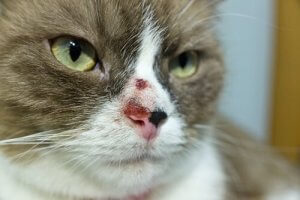Feline Skin Cancer - Causes and Treatment

Cancer is the abnormal proliferation of cells that can invade all kinds of tissues and organs such as the skin. Squamous cell carcinoma (SCC) is the most common feline skin cancer.
It usually appears on the ears, nose, lips, eyelids, and in the less-protected areas of the skin. However, tumors inside the mouth are also frequent. This is more common in older cats and related to sun exposure though. It’s also frequent in white cats.
Causes of cancer in cats
The exact causes in the vast majority of cancer cases are unknown. But, there are factors that can influence its appearance:
- Some breeds of cats have a greater genetic predisposition to cancer than others and the same occurs at an individual level.
- What an animal eats greatly influences their health. Certain types of food can help to prevent cancer due to their physical-chemical properties, while an excess of other types of food can lead to other types of cancer.
- Pollution, tobacco smoke, and sun exposure can also lead to skin cancer in cats. Like humans, excessive sun exposure can cause skin lesions and cancer, especially in their most unprotected areas.

How do vets detect feline skin cancer?
Squamous cell carcinoma appears as pink lesions, localized alopecia, and scabs that one could mistake for wounds. As the disease worsens, the cat’s skin becomes redder in appearance and there may also be ulcerated areas with harder edges.
Skin cancer affects the ears, nose, lips, and mouth, although the tumor spreads quickly and destroys the surrounding tissue. Thus, it can invade other areas of the body such as the inside of the oral cavity, the nodes, and the lungs.
As always, an early diagnosis is important in the treatment of this disease. So, consult your vet to confirm or rule out the diagnosis if you notice these sorts of lesions. They must do an examination and a biopsy of the most affected areas to confirm cancer.
The most advanced and precise radiography, as well as computerized tomography, are diagnostic tools with which to look for carcinogenic masses and their progress. They’re particularly useful when the masses occur inside the oral cavity, which is frequent in this type of cancer.
Skin cancer treatments in felines
The success of a certain treatment depends on the severity of the disease in a particular case. If the lesions are minor, a doctor can treat them. You can prevent them though. For instance, either avoid exposure to the sun in the hours of maximum radiation or apply a protective sun cream on your animal’s most vulnerable areas. Keep in mind that this won’t be an easy task.

If the lesions are severe and you’re dealing with a case of squamous cell cancer, then there are several possible treatments:
- Surgical removal of the tumor. The earlier a doctor performs this technique, the better, as it’ll prevent the tumor from progressing to the healthy skin areas. To do so, they must remove all cancerous tissue and a margin of healthy tissue around it to prevent recurrences. If only the ears are affected, as is often the case, removal may be the best solution.
- Radiotherapy. Doctors can combine radiation therapy with the previous method to ensure the complete elimination of any traces of cancer. This technique is usually more expensive and only the most specialized veterinary centers offer it.
- Chemotherapy. This kind of drug treatment can decrease cancerous masses. So, your vet will determine the dosage.
Thanks for reading.
Cancer is the abnormal proliferation of cells that can invade all kinds of tissues and organs such as the skin. Squamous cell carcinoma (SCC) is the most common feline skin cancer.
It usually appears on the ears, nose, lips, eyelids, and in the less-protected areas of the skin. However, tumors inside the mouth are also frequent. This is more common in older cats and related to sun exposure though. It’s also frequent in white cats.
Causes of cancer in cats
The exact causes in the vast majority of cancer cases are unknown. But, there are factors that can influence its appearance:
- Some breeds of cats have a greater genetic predisposition to cancer than others and the same occurs at an individual level.
- What an animal eats greatly influences their health. Certain types of food can help to prevent cancer due to their physical-chemical properties, while an excess of other types of food can lead to other types of cancer.
- Pollution, tobacco smoke, and sun exposure can also lead to skin cancer in cats. Like humans, excessive sun exposure can cause skin lesions and cancer, especially in their most unprotected areas.

How do vets detect feline skin cancer?
Squamous cell carcinoma appears as pink lesions, localized alopecia, and scabs that one could mistake for wounds. As the disease worsens, the cat’s skin becomes redder in appearance and there may also be ulcerated areas with harder edges.
Skin cancer affects the ears, nose, lips, and mouth, although the tumor spreads quickly and destroys the surrounding tissue. Thus, it can invade other areas of the body such as the inside of the oral cavity, the nodes, and the lungs.
As always, an early diagnosis is important in the treatment of this disease. So, consult your vet to confirm or rule out the diagnosis if you notice these sorts of lesions. They must do an examination and a biopsy of the most affected areas to confirm cancer.
The most advanced and precise radiography, as well as computerized tomography, are diagnostic tools with which to look for carcinogenic masses and their progress. They’re particularly useful when the masses occur inside the oral cavity, which is frequent in this type of cancer.
Skin cancer treatments in felines
The success of a certain treatment depends on the severity of the disease in a particular case. If the lesions are minor, a doctor can treat them. You can prevent them though. For instance, either avoid exposure to the sun in the hours of maximum radiation or apply a protective sun cream on your animal’s most vulnerable areas. Keep in mind that this won’t be an easy task.

If the lesions are severe and you’re dealing with a case of squamous cell cancer, then there are several possible treatments:
- Surgical removal of the tumor. The earlier a doctor performs this technique, the better, as it’ll prevent the tumor from progressing to the healthy skin areas. To do so, they must remove all cancerous tissue and a margin of healthy tissue around it to prevent recurrences. If only the ears are affected, as is often the case, removal may be the best solution.
- Radiotherapy. Doctors can combine radiation therapy with the previous method to ensure the complete elimination of any traces of cancer. This technique is usually more expensive and only the most specialized veterinary centers offer it.
- Chemotherapy. This kind of drug treatment can decrease cancerous masses. So, your vet will determine the dosage.
Thanks for reading.
All cited sources were thoroughly reviewed by our team to ensure their quality, reliability, currency, and validity. The bibliography of this article was considered reliable and of academic or scientific accuracy.
- AVEPA. Carcinoma de células escamosas en gatos.
- AVEPA. Cáncer en gatos. ¿Que tratamientos hay al alcance de los gatos?.
- Affinity-petcare. Carcinoma de células escamosas en gatos. TC y tiempo de supervivencia.
- PortalVeterinaria. Tratamiento médico de un carcinoma de células escamosas oral maxilar.
This text is provided for informational purposes only and does not replace consultation with a professional. If in doubt, consult your specialist.








